display FIAT DOBLO COMBI 2015 2.G User Guide
[x] Cancel search | Manufacturer: FIAT, Model Year: 2015, Model line: DOBLO COMBI, Model: FIAT DOBLO COMBI 2015 2.GPages: 323, PDF Size: 46.77 MB
Page 73 of 323
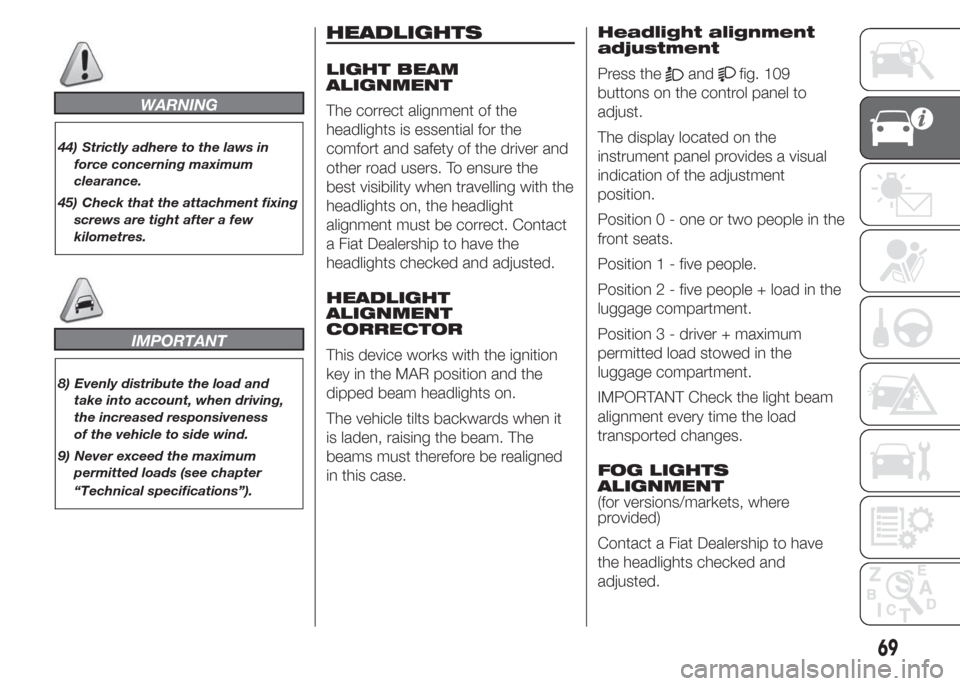
WARNING
44) Strictly adhere to the laws in
force concerning maximum
clearance.
45) Check that the attachment fixing
screws are tight after a few
kilometres.
IMPORTANT
8) Evenly distribute the load and
take into account, when driving,
the increased responsiveness
of the vehicle to side wind.
9) Never exceed the maximum
permitted loads (see chapter
“Technical specifications”).
HEADLIGHTS
LIGHT BEAM
ALIGNMENT
The correct alignment of the
headlights is essential for the
comfort and safety of the driver and
other road users. To ensure the
best visibility when travelling with the
headlights on, the headlight
alignment must be correct. Contact
a Fiat Dealership to have the
headlights checked and adjusted.
HEADLIGHT
ALIGNMENT
CORRECTOR
This device works with the ignition
key in the MAR position and the
dipped beam headlights on.
The vehicle tilts backwards when it
is laden, raising the beam. The
beams must therefore be realigned
in this case.Headlight alignment
adjustment
Press theandfig. 109
buttons on the control panel to
adjust.
The display located on the
instrument panel provides a visual
indication of the adjustment
position.
Position 0 - one or two people in the
front seats.
Position 1 - five people.
Position 2 - five people + load in the
luggage compartment.
Position 3 - driver + maximum
permitted load stowed in the
luggage compartment.
IMPORTANT Check the light beam
alignment every time the load
transported changes.
FOG LIGHTS
ALIGNMENT
(for versions/markets, where
provided)
Contact a Fiat Dealership to have
the headlights checked and
adjusted.
69
Page 76 of 323
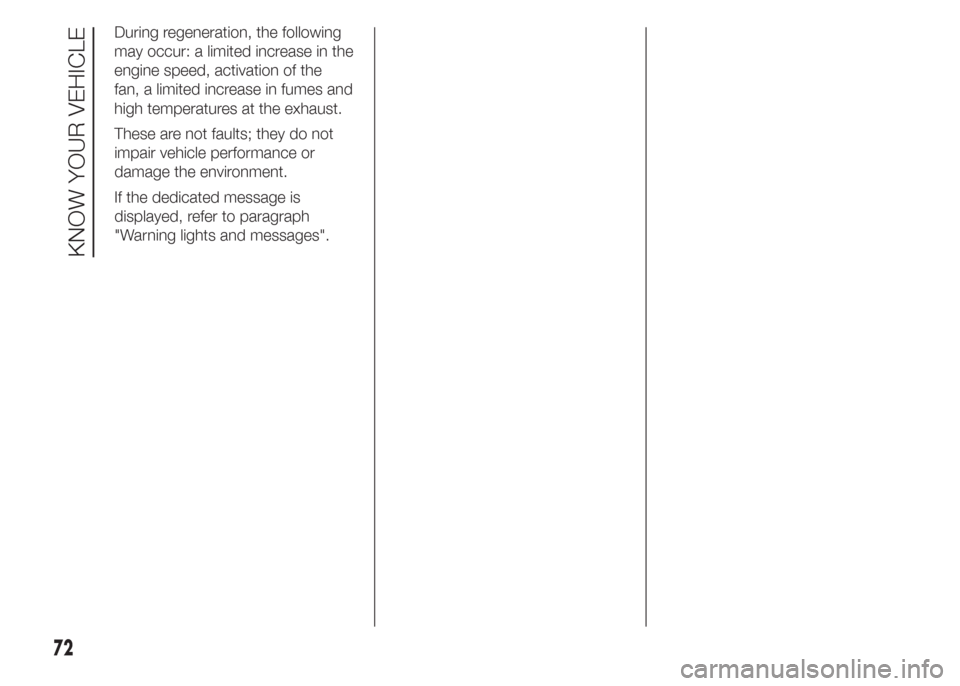
During regeneration, the following
may occur: a limited increase in the
engine speed, activation of the
fan, a limited increase in fumes and
high temperatures at the exhaust.
These are not faults; they do not
impair vehicle performance or
damage the environment.
If the dedicated message is
displayed, refer to paragraph
"Warning lights and messages".
72
KNOW YOUR VEHICLE
Page 77 of 323
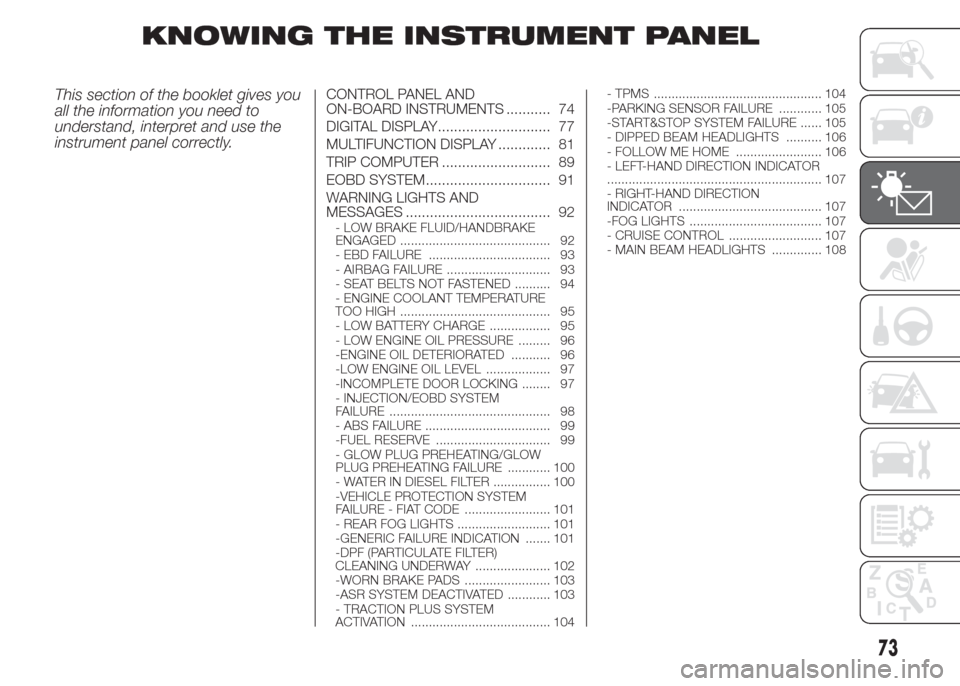
KNOWING THE INSTRUMENT PANEL
This section of the booklet gives you
all the information you need to
understand, interpret and use the
instrument panel correctly.CONTROL PANEL AND
ON-BOARD INSTRUMENTS ........... 74
DIGITAL DISPLAY............................ 77
MULTIFUNCTION DISPLAY ............. 81
TRIP COMPUTER ........................... 89
EOBD SYSTEM............................... 91
WARNING LIGHTS AND
MESSAGES .................................... 92
- LOW BRAKE FLUID/HANDBRAKE
ENGAGED .......................................... 92
- EBD FAILURE .................................. 93
- AIRBAG FAILURE ............................. 93
- SEAT BELTS NOT FASTENED .......... 94
- ENGINE COOLANT TEMPERATURE
TOO HIGH .......................................... 95
- LOW BATTERY CHARGE ................. 95
- LOW ENGINE OIL PRESSURE ......... 96
-ENGINE OIL DETERIORATED ........... 96
-LOW ENGINE OIL LEVEL .................. 97
-INCOMPLETE DOOR LOCKING ........ 97
- INJECTION/EOBD SYSTEM
FAILURE ............................................. 98
- ABS FAILURE ................................... 99
-FUEL RESERVE ................................ 99
- GLOW PLUG PREHEATING/GLOW
PLUG PREHEATING FAILURE ............ 100
- WATER IN DIESEL FILTER ................ 100
-VEHICLE PROTECTION SYSTEM
FAILURE - FIAT CODE ........................ 101
- REAR FOG LIGHTS .......................... 101
-GENERIC FAILURE INDICATION ....... 101
-DPF (PARTICULATE FILTER)
CLEANING UNDERWAY ..................... 102
-WORN BRAKE PADS ........................ 103
-ASR SYSTEM DEACTIVATED ............ 103
- TRACTION PLUS SYSTEM
ACTIVATION ....................................... 104- TPMS ............................................... 104
-PARKING SENSOR FAILURE ............ 105
-START&STOP SYSTEM FAILURE ...... 105
- DIPPED BEAM HEADLIGHTS .......... 106
- FOLLOW ME HOME ........................ 106
- LEFT-HAND DIRECTION INDICATOR
............................................................ 107
- RIGHT-HAND DIRECTION
INDICATOR ........................................ 107
-FOG LIGHTS ..................................... 107
- CRUISE CONTROL .......................... 107
- MAIN BEAM HEADLIGHTS .............. 108
73
Page 78 of 323
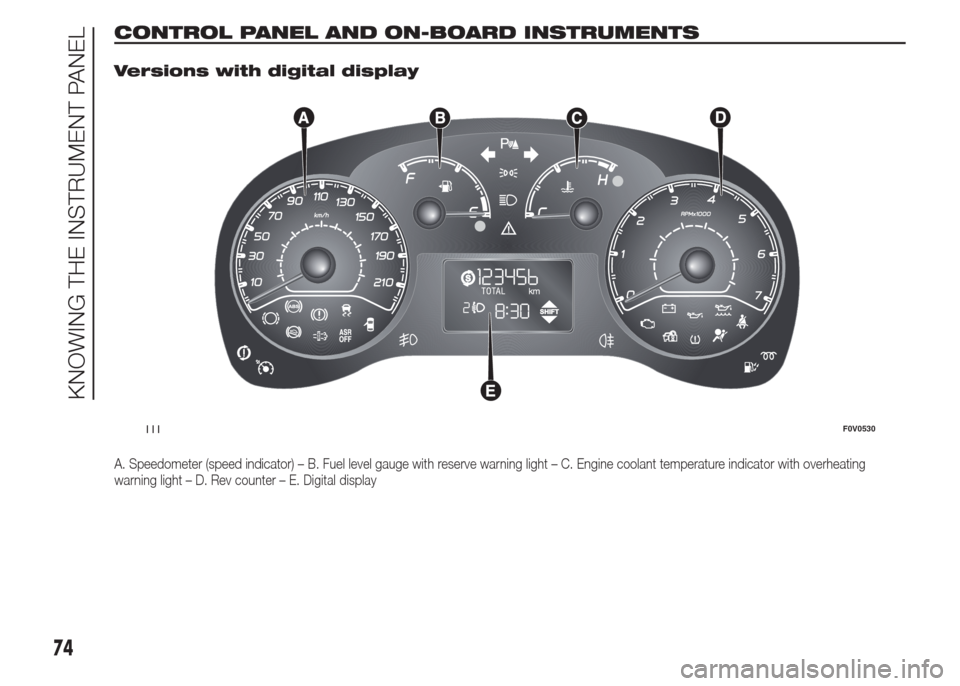
CONTROL PANEL AND ON-BOARD INSTRUMENTS.
Versions with digital display
A. Speedometer (speed indicator) – B. Fuel level gauge with reserve warning light – C. Engine coolant temperature indicator with overheating
warning light – D. Rev counter – E. Digital display
111F0V0530
74
KNOWING THE INSTRUMENT PANEL
Page 79 of 323
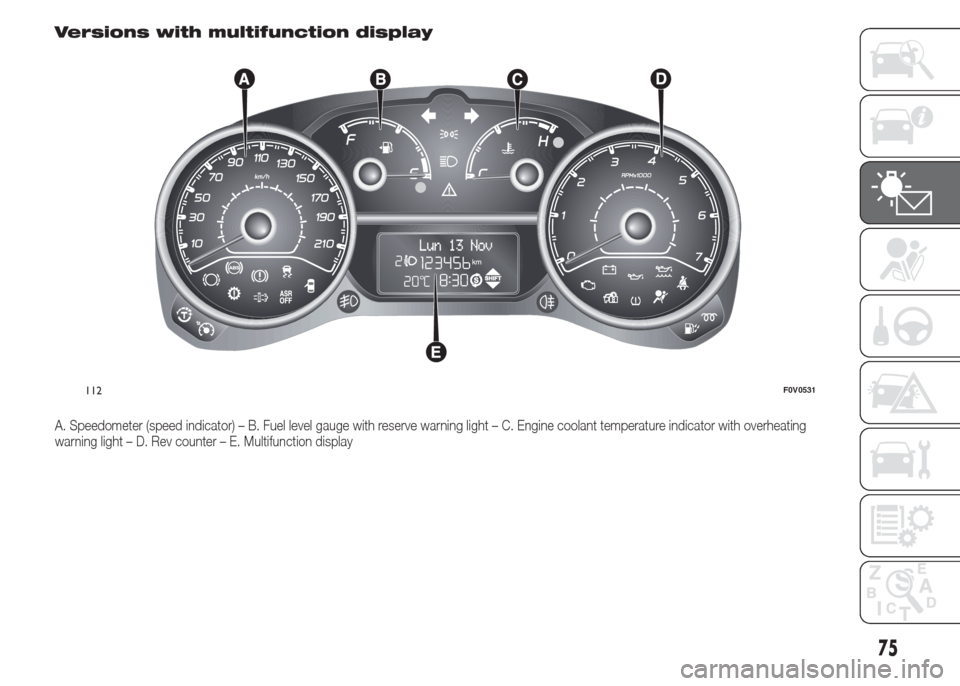
Versions with multifunction display
A. Speedometer (speed indicator) – B. Fuel level gauge with reserve warning light – C. Engine coolant temperature indicator with overheating
warning light – D. Rev counter – E. Multifunction display
112F0V0531
75
Page 80 of 323
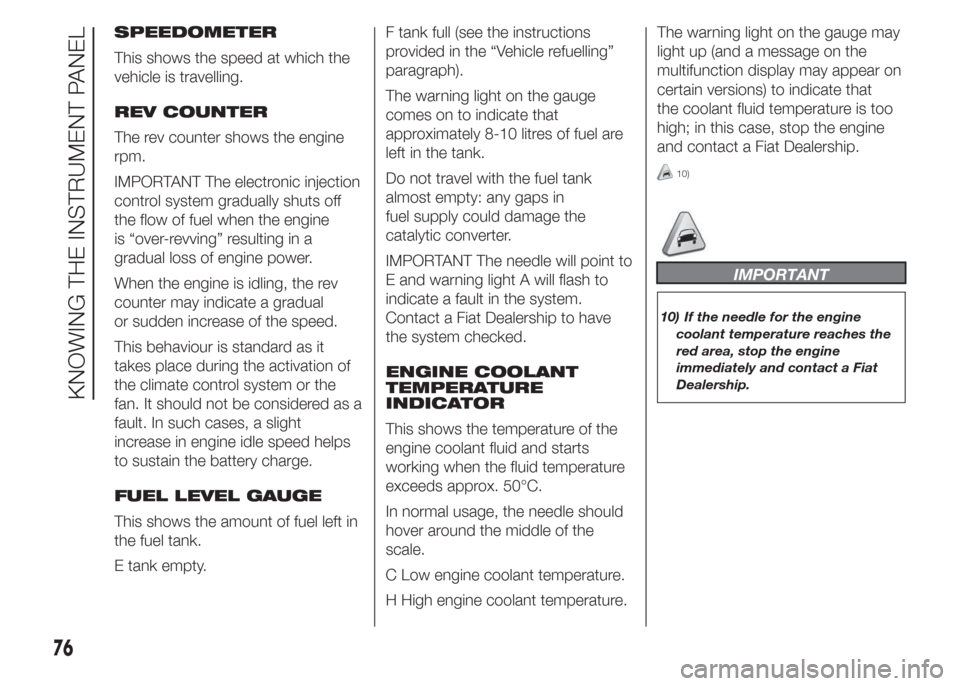
SPEEDOMETER
This shows the speed at which the
vehicle is travelling.
REV COUNTER
The rev counter shows the engine
rpm.
IMPORTANT The electronic injection
control system gradually shuts off
the flow of fuel when the engine
is “over-revving” resulting in a
gradual loss of engine power.
When the engine is idling, the rev
counter may indicate a gradual
or sudden increase of the speed.
This behaviour is standard as it
takes place during the activation of
the climate control system or the
fan. It should not be considered as a
fault. In such cases, a slight
increase in engine idle speed helps
to sustain the battery charge.
FUEL LEVEL GAUGE
This shows the amount of fuel left in
the fuel tank.
E tank empty.F tank full (see the instructions
provided in the “Vehicle refuelling”
paragraph).
The warning light on the gauge
comes on to indicate that
approximately 8-10 litres of fuel are
left in the tank.
Do not travel with the fuel tank
almost empty: any gaps in
fuel supply could damage the
catalytic converter.
IMPORTANT The needle will point to
E and warning light A will flash to
indicate a fault in the system.
Contact a Fiat Dealership to have
the system checked.
ENGINE COOLANT
TEMPERATURE
INDICATOR
This shows the temperature of the
engine coolant fluid and starts
working when the fluid temperature
exceeds approx. 50°C.
In normal usage, the needle should
hover around the middle of the
scale.
C Low engine coolant temperature.
H High engine coolant temperature.The warning light on the gauge may
light up (and a message on the
multifunction display may appear on
certain versions) to indicate that
the coolant fluid temperature is too
high; in this case, stop the engine
and contact a Fiat Dealership.
10)
IMPORTANT
10) If the needle for the engine
coolant temperature reaches the
red area, stop the engine
immediately and contact a Fiat
Dealership.
76
KNOWING THE INSTRUMENT PANEL
Page 81 of 323
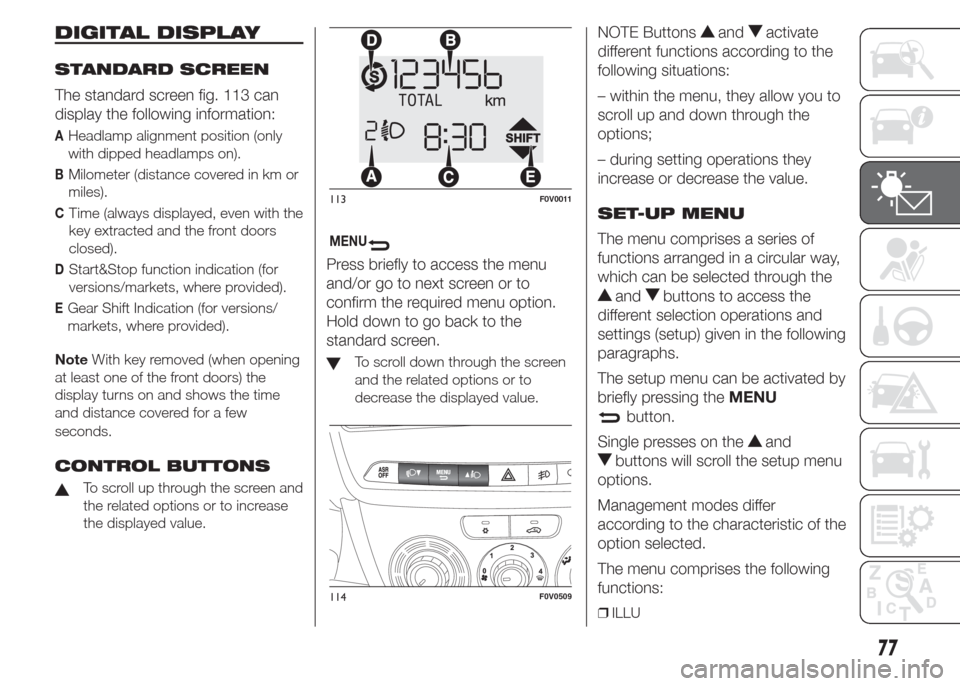
DIGITAL DISPLAY
STANDARD SCREEN
The standard screen fig. 113 can
display the following information:
AHeadlamp alignment position (only
with dipped headlamps on).
BMilometer (distance covered in km or
miles).
CTime (always displayed, even with the
key extracted and the front doors
closed).
DStart&Stop function indication (for
versions/markets, where provided).
EGear Shift Indication (for versions/
markets, where provided).
NoteWith key removed (when opening
at least one of the front doors) the
display turns on and shows the time
and distance covered for a few
seconds.
CONTROL BUTTONS
To scroll up through the screen and
the related options or to increase
the displayed value.
MENU
Press briefly to access the menu
and/or go to next screen or to
confirm the required menu option.
Hold down to go back to the
standard screen.
To scroll down through the screen
and the related options or to
decrease the displayed value.
NOTE Buttonsandactivate
different functions according to the
following situations:
– within the menu, they allow you to
scroll up and down through the
options;
– during setting operations they
increase or decrease the value.
SET-UP MENU
The menu comprises a series of
functions arranged in a circular way,
which can be selected through the
andbuttons to access the
different selection operations and
settings (setup) given in the following
paragraphs.
The setup menu can be activated by
briefly pressing theMENU
button.
Single presses on the
and
buttons will scroll the setup menu
options.
Management modes differ
according to the characteristic of the
option selected.
The menu comprises the following
functions:
❒ILLU
113F0V0011
114F0V0509
77
Page 82 of 323
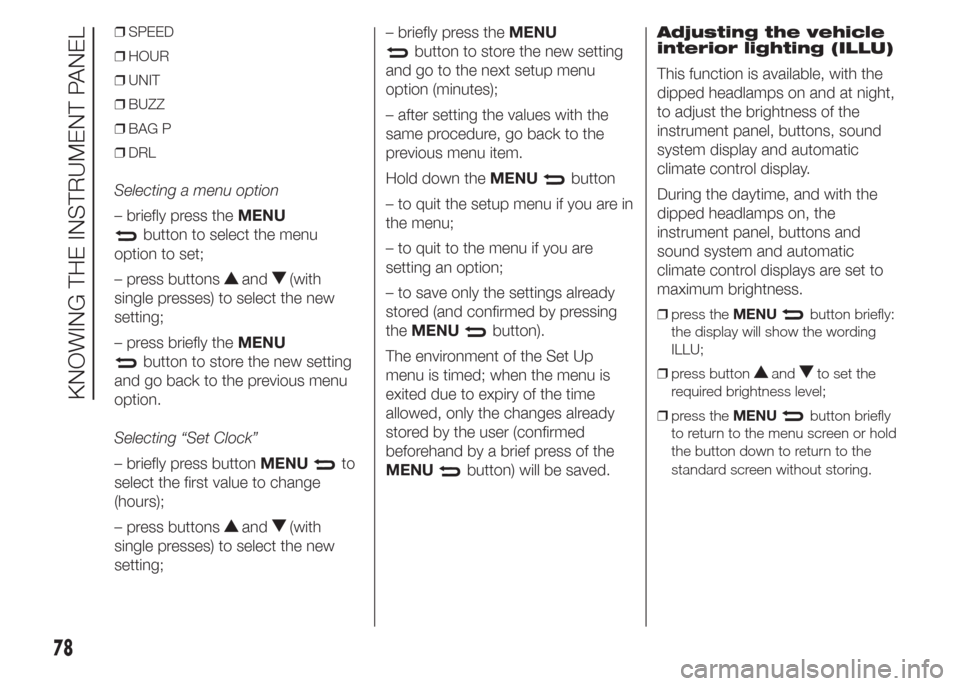
❒SPEED
❒HOUR
❒UNIT
❒BUZZ
❒BAG P
❒DRL
Selecting a menu option
– briefly press theMENU
button to select the menu
option to set;
– press buttons
and(with
single presses) to select the new
setting;
– press briefly theMENU
button to store the new setting
and go back to the previous menu
option.
Selecting “Set Clock”
– briefly press buttonMENU
to
select the first value to change
(hours);
– press buttons
and(with
single presses) to select the new
setting;– briefly press theMENU
button to store the new setting
and go to the next setup menu
option (minutes);
– after setting the values with the
same procedure, go back to the
previous menu item.
Hold down theMENU
button
– to quit the setup menu if you are in
the menu;
– to quit to the menu if you are
setting an option;
– to save only the settings already
stored (and confirmed by pressing
theMENU
button).
The environment of the Set Up
menu is timed; when the menu is
exited due to expiry of the time
allowed, only the changes already
stored by the user (confirmed
beforehand by a brief press of the
MENU
button) will be saved.Adjusting the vehicle
interior lighting (ILLU)
This function is available, with the
dipped headlamps on and at night,
to adjust the brightness of the
instrument panel, buttons, sound
system display and automatic
climate control display.
During the daytime, and with the
dipped headlamps on, the
instrument panel, buttons and
sound system and automatic
climate control displays are set to
maximum brightness.
❒press theMENUbutton briefly:
the display will show the wording
ILLU;
❒press button
andto set the
required brightness level;
❒press theMENU
button briefly
to return to the menu screen or hold
the button down to return to the
standard screen without storing.
78
KNOWING THE INSTRUMENT PANEL
Page 83 of 323
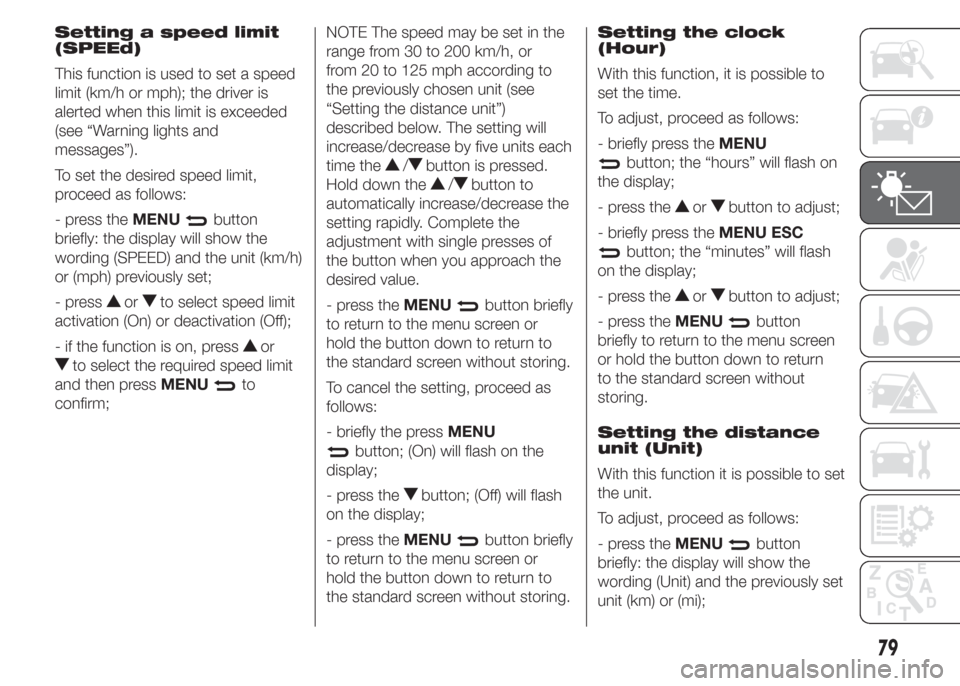
Setting a speed limit
(SPEEd)
This function is used to set a speed
limit (km/h or mph); the driver is
alerted when this limit is exceeded
(see “Warning lights and
messages”).
To set the desired speed limit,
proceed as follows:
- press theMENU
button
briefly: the display will show the
wording (SPEED) and the unit (km/h)
or (mph) previously set;
- press
orto select speed limit
activation (On) or deactivation (Off);
- if the function is on, press
or
to select the required speed limit
and then pressMENU
to
confirm;NOTE The speed may be set in the
range from 30 to 200 km/h, or
from 20 to 125 mph according to
the previously chosen unit (see
“Setting the distance unit”)
described below. The setting will
increase/decrease by five units each
time the
/button is pressed.
Hold down the
/button to
automatically increase/decrease the
setting rapidly. Complete the
adjustment with single presses of
the button when you approach the
desired value.
- press theMENU
button briefly
to return to the menu screen or
hold the button down to return to
the standard screen without storing.
To cancel the setting, proceed as
follows:
- briefly the pressMENU
button; (On) will flash on the
display;
- press the
button; (Off) will flash
on the display;
- press theMENU
button briefly
to return to the menu screen or
hold the button down to return to
the standard screen without storing.Setting the clock
(Hour)
With this function, it is possible to
set the time.
To adjust, proceed as follows:
- briefly press theMENU
button; the “hours” will flash on
the display;
- press the
orbutton to adjust;
- briefly press theMENU ESC
button; the “minutes” will flash
on the display;
- press the
orbutton to adjust;
- press theMENU
button
briefly to return to the menu screen
or hold the button down to return
to the standard screen without
storing.
Setting the distance
unit (Unit)
With this function it is possible to set
the unit.
To adjust, proceed as follows:
- press theMENU
button
briefly: the display will show the
wording (Unit) and the previously set
unit (km) or (mi);
79
Page 84 of 323
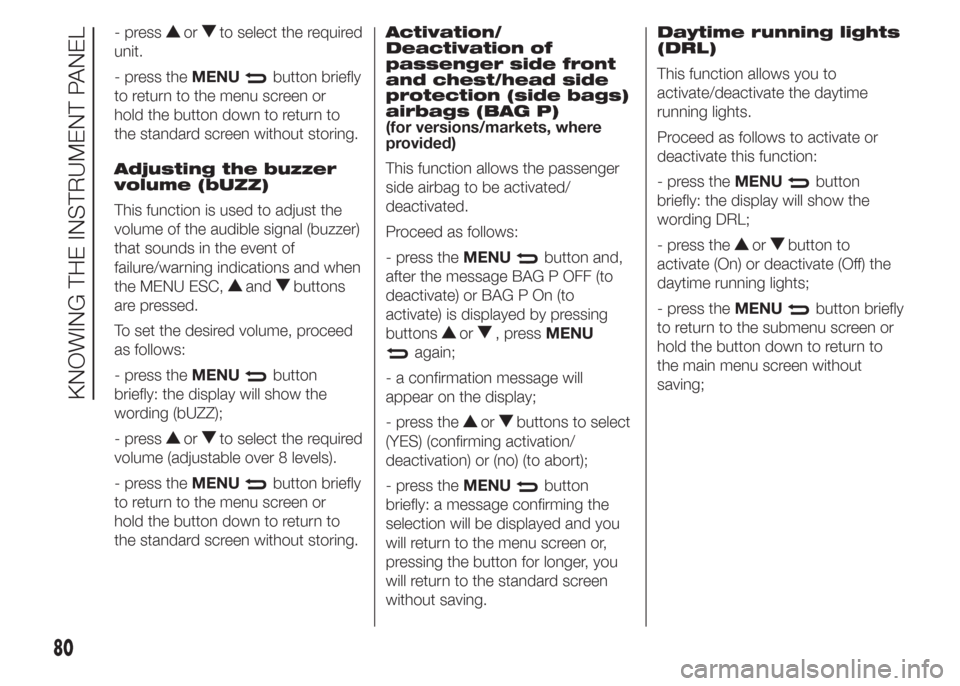
- pressorto select the required
unit.
- press theMENU
button briefly
to return to the menu screen or
hold the button down to return to
the standard screen without storing.
Adjusting the buzzer
volume (bUZZ)
This function is used to adjust the
volume of the audible signal (buzzer)
that sounds in the event of
failure/warning indications and when
the MENU ESC,
andbuttons
are pressed.
To set the desired volume, proceed
as follows:
- press theMENU
button
briefly: the display will show the
wording (bUZZ);
- press
orto select the required
volume (adjustable over 8 levels).
- press theMENU
button briefly
to return to the menu screen or
hold the button down to return to
the standard screen without storing.Activation/
Deactivation of
passenger side front
and chest/head side
protection (side bags)
airbags (BAG P)
(for versions/markets, where
provided)
This function allows the passenger
side airbag to be activated/
deactivated.
Proceed as follows:
- press theMENU
button and,
after the message BAG P OFF (to
deactivate) or BAG P On (to
activate) is displayed by pressing
buttons
or, pressMENU
again;
- a confirmation message will
appear on the display;
- press the
orbuttons to select
(YES) (confirming activation/
deactivation) or (no) (to abort);
- press theMENU
button
briefly: a message confirming the
selection will be displayed and you
will return to the menu screen or,
pressing the button for longer, you
will return to the standard screen
without saving.Daytime running lights
(DRL)
This function allows you to
activate/deactivate the daytime
running lights.
Proceed as follows to activate or
deactivate this function:
- press theMENU
button
briefly: the display will show the
wording DRL;
- press the
orbutton to
activate (On) or deactivate (Off) the
daytime running lights;
- press theMENU
button briefly
to return to the submenu screen or
hold the button down to return to
the main menu screen without
saving;
80
KNOWING THE INSTRUMENT PANEL